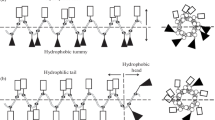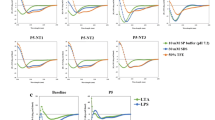Abstract
In recent years, the widespread use of antibiotics has caused many bacterial pathogens resistance to conventional antibiotics. Therefore, generation of new antibiotics to control and reduce the effects of these pathogens is urgently needed. Antimicrobial peptides and proteins are important members of the host defense system in eukaryotes. These peptides are potent, broad-spectrum antibiotics that demonstrate potential as novel and alternative therapeutic agents for the treatment of drug-resistant infections. Accordingly, we evaluated two hybrid peptides CM11 (WKLFKKILKVL-NH2) and CM15 (KWKLFKKIGAVLKVL-NH2) on five important pathogenic bacteria. These peptides are short cecropin–melittin hybrid peptides obtained through a sequence combination approach, which are highly effective to inhibit the growth of important pathogenic bacteria. The activity of these two cationic peptides (CM11 and CM15) in different concentrations (2–64 mg/L) was investigated against standard and clinical isolates of important hospital infection bacteria by measuring MIC, MBC, and bactericidal assay. These peptides demonstrated the same ranges of inhibitory values: The organisms in early 24 h were more susceptible to polycationic peptides (MIC: 8 mg/L and MBC 32 mg/L), but after 48 h the MIC and MBC remained constant for the CM11 peptide. Bactericidal assay showed that all bacteria strains did not have any growth in agar plates after 40 min. The result showed that these two peptides are more effective than other peptides.

Similar content being viewed by others
References
Brogden KA, Ackermann M, McCray PB Jr, Tack BF (2003) Antimicrobial peptides in animals and their role in host defences. Int J Antimicrob Agents 22(5):465–478
Bulet P, Stocklin R, Menin L (2004) Anti-microbial peptides: from invertebrates to vertebrates. Immunol Rev 198:169–184
Otvos L Jr (2000) Antibacterial peptides isolated from insects. J Pept Sci 6(10):497–511
Zasloff M (2002) Antimicrobial peptides of multicellular organisms. Nature 415(6870):389–395
Wang J, Wong ES, Whitley JC, Li J, Stringer JM, Short KR, Renfree MB, Belov K, Cocks BG (2011) Ancient antimicrobial peptides kill antibiotic-resistant pathogens: Australian mammals provide new options. PLoS ONE 6(8):e24030
Hancock RE, Patrzykat A (2002) Clinical development of cationic antimicrobial peptides: from natural to novel antibiotics. Curr Drug Targets Infect Disord 2(1):79–83
Hancock RE, Sahl HG (2006) Antimicrobial and host-defense peptides as new anti-infective therapeutic strategies. Nat Biotechnol 24(12):1551–1557
Gordon YJ, Romanowski EG, McDermott AM (2005) A review of antimicrobial peptides and their therapeutic potential as anti-infective drugs. Curr Eye Res 30(7):505–515
Boman HG (2003) Antibacterial peptides: basic facts and emerging concepts. J Intern Med 254(3):197–215
Jenssen H, Hamill P, Hancock RE (2006) Peptide antimicrobial agents. Clin Microbiol Rev 19(3):491–511
Montesinos E (2007) Antimicrobial peptides and plant disease control. FEMS Microbiol Lett 270(1):1–11
Zhang L, Falla TJ (2006) Antimicrobial peptides: therapeutic potential. Expert Opin Pharmacother 7(6):653–663
Brogden KA (2005) Antimicrobial peptides: pore formers or metabolic inhibitors in bacteria? Nat Rev Microbiol 3(3):238–250
Yeaman MR, Yount NY (2003) Mechanisms of antimicrobial peptide action and resistance. Pharmacol Rev 55(1):27–55
Ferre R, Melo MN, Correia AD, Feliu L, Bardaji E, Planas M, Castanho M (2009) Synergistic effects of the membrane actions of cecropin-melittin antimicrobial hybrid peptide BP100. Biophys J 96(5):1815–1827
Gentilucci L, Tolomelli A, Squassabia F (2006) Peptides and peptidomimetics in medicine, surgery and biotechnology. Curr Med Chem 13(20):2449–2466
Lehrer RI, Lichtenstein AK, Ganz T (1993) Defensins: antimicrobial and cytotoxic peptides of mammalian cells. Annu Rev Immunol 11:105–128
Boman HG, Faye I, Gudmundsson GH, Lee JY, Lidholm DA (1991) Cell-free immunity in Cecropia. A model system for antibacterial proteins. Eur J Biochem 201(1):23–31
Zasloff M (1987) Magainins, a class of antimicrobial peptides from Xenopus skin: isolation, characterization of two active forms, and partial cDNA sequence of a precursor. Proc Natl Acad Sci USA 84(15):5449–5453
Dempsey CE (1990) The actions of melittin on membranes. Biochim Biophys Acta 1031(2):143–161
Steiner H (1982) Secondary structure of the cecropins: antibacterial peptides from the moth H. cecropia. FEBS Lett 137(2):283–287
Moore AJ, Beazley WD, Bibby MC, Devine DA (1996) Antimicrobial activity of cecropins. J Antimicrob Chemother 37(6):1077–1089
Tamang DG, Saier MH Jr (2006) The cecropin superfamily of toxic peptides. J Mol Microbiol Biotechnol 11(1–2):94–103
Andreu D, Ubach J, Boman A, Wahlin B, Wade D, Merrifield RB, Boman HG (1992) Shortened cecropin. A-melittin hybrids significant size reduction retains potent antibiotic activity. FEBS Lett 296(2):190–194
Wade D, Andreu D, Mitchell SA, Silveira AM, Boman A, Boman HG, Merrifield RB (1992) Antibacterial peptides designed as analogs or hybrids of cecropins and melittin. Int J Pept Protein Res 40(5):429–436
Saugar JM, Rodriguez-Hernandez MJ, de la Torre BG, Pachon-Ibanez ME, Fernandez-Reyes M, Andreu D, Pachon J, Rivas L (2006) Activity of cecropin A-melittin hybrid peptides against colistin-resistant clinical strains of A. baumannii: molecular basis for the differential mechanisms of action. Antimicrob Agents Chemother 50(4):1251–1256
Christensen B, Fink J, Merrifield RB, Mauzerall D (1988) Channel-forming properties of cecropins and related model compounds incorporated into planar lipid membranes. Proc Natl Acad Sci USA 85(14):5072–5076
David SA (2001) Towards a rational development of anti-endotoxin agents: novel approaches to sequestration of bacterial endotoxins with small molecules. J Mol Recognit 14:370–387
Giacometti A, Cirioni O, Kamysz W, D’Amato G, Silvestri C, Simona Del Prete M, Lukasiak J, Scalise G (2004) In vitro activity and killing effect of the synthetic hybrid cecropin A-melittin peptide CA(1–7)M(2–9)NH(2) on methicillin-resistant nosocomial isolates of S. aureus and interactions with clinically used antibiotics. Diagn Microbiol Infect Dis 49(3):197–200
Jarvis WR (2003) Epidemiology and control of P. aeruginosa infections in the intensive care unit. In: Hauser AR, Rello J (eds) Severe infections caused by P. aeruginosa. Kluwer Academic, Boston
Cisneros JM, Rodriguez-Bano J (2002) Nosocomial bacteremia due to A. baumannii : epidemiology, clinical features and treatment. Clin Microbiol Infect 8(11):687–693
Richards MJ, Edwards JR, Culver DH, Gaynes RP (1999) Nosocomial infections in medical intensive care units in the United States. National nosocomial infections surveillance system. Crit Care Med 27(5):887–892
Navon-Venezia S, Ben-Ami R, Carmeli Y (2005) Update on P. aeruginosa and A. baumannii infections in the healthcare setting. Curr Opin Infect Dis 18(4):306–313
Van Looveren M, Goossens H (2004) Antimicrobial resistance of Acinetobacter spp. in Europe. Clin Microbiol Infect 10(8):684–704
Liu C, Bayer A, Cosgrove SE, Daum RS, Fridkin SK, Gorwitz RJ, Kaplan SL, Karchmer AW, Levine DP, Murray BE MJR, Talan DA, Chambers HF (2011) Clinical practice guidelines by the infectious diseases society of america for the treatment of methicillin-resistant S. aureus infections in adults and children: executive summary. Clin Infect Dis 52(3):285–292
Bean DC, Krahe D, Wareham DW (2008) Antimicrobial resistance incommunity and nosocomial E. coli urinary tract isolates, London 2005–2006. Ann Clin Microbiol Antimicrob 7:13
Kitaoka M, Miyata ST, Unterweger D, Pukatzki S (2011) Antibiotic resistance mechanisms of Vibrio cholera. J Med Microbiol 60(4):397–407
Badosa E, Ferre R, Planas M, Feliu L, Besalu E, Cabrefiga J, Bardaji E, Montesinos E (2007) A library of linear undecapeptides with bactericidal activity against phytopathogenic bacteria. Peptides 28(12):2276–2285
National Committee for Clinical Laboratory Standards (2010) Methods for dilution antimicrobial susceptibility tests for bacteria that grow aerobically: Approved standard M7-A6. Villanova, PA
Bechinger B (2004) Structure and function of membrane-lytic peptides. Crit Rev Plant Sci 23:271–292
Vogel H, Jahnig F (1986) The structure of melittin in membranes. Biophys J 50(4):573–582
Piers KL, Brown MH, Hancock RE (1994) Improvement of outer membrane-permeabilizing and lipopolysaccharide-binding activities of an antimicrobial cationic peptide by C-terminal modification. Antimicrob Agents Chemother 38(10):2311–2316
Sawyer JG, Martin NL, Hancock RE (1988) Interaction of macrophage cationic proteins with the outer membrane of P. aeruginosa. Infect Immun 56(3):693–698
Rodriguez-Hernandez MJ, Saugar J, Docobo-Perez F, de la Torre BG, Pachon-Ibanez ME, Garcia-Curiel A, Fernandez-Cuenca F, Andreu D, Rivas L, Pachon J (2006) Studies on the antimicrobial activity of cecropin A-melittin hybrid peptides in colistin-resistant clinical isolates of A. baumannii. J Antimicrob Chemother 58(1):95–100
Ferre R, Badosa E, Feliu L, Planas M, Montesinos E, Bardaji E (2006) Inhibition of plant-pathogenic bacteria by short synthetic cecropin A-melittin hybrid peptides. Appl Environ Microbiol 72(5):3302–3308
Acknowledgments
We thank from clinical microbiology laboratory of Baqiyatallah, Khatam al anbia and Shahid motahari hospitals for preparing bacterial strains.
Author information
Authors and Affiliations
Corresponding authors
Rights and permissions
About this article
Cite this article
Moghaddam, M.M., Abolhassani, F., Babavalian, H. et al. Comparison of in vitro antibacterial activities of two cationic peptides CM15 and CM11 against five pathogenic bacteria: Pseudomonas aeruginosa, Staphylococcus aureus, Vibrio cholerae, Acinetobacter baumannii, and Escherichia coli . Probiotics & Antimicro. Prot. 4, 133–139 (2012). https://doi.org/10.1007/s12602-012-9098-7
Published:
Issue Date:
DOI: https://doi.org/10.1007/s12602-012-9098-7




